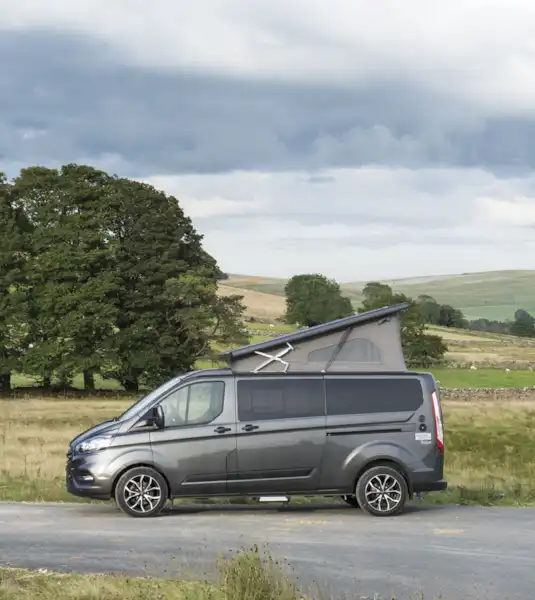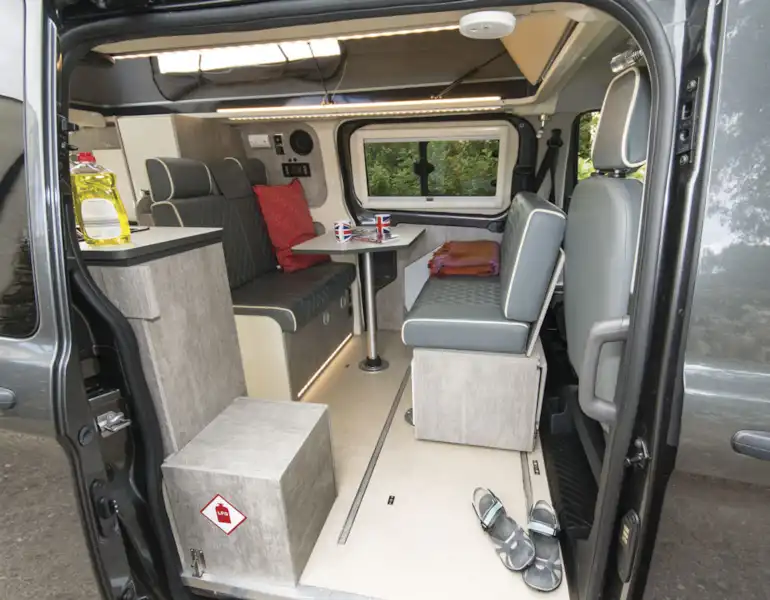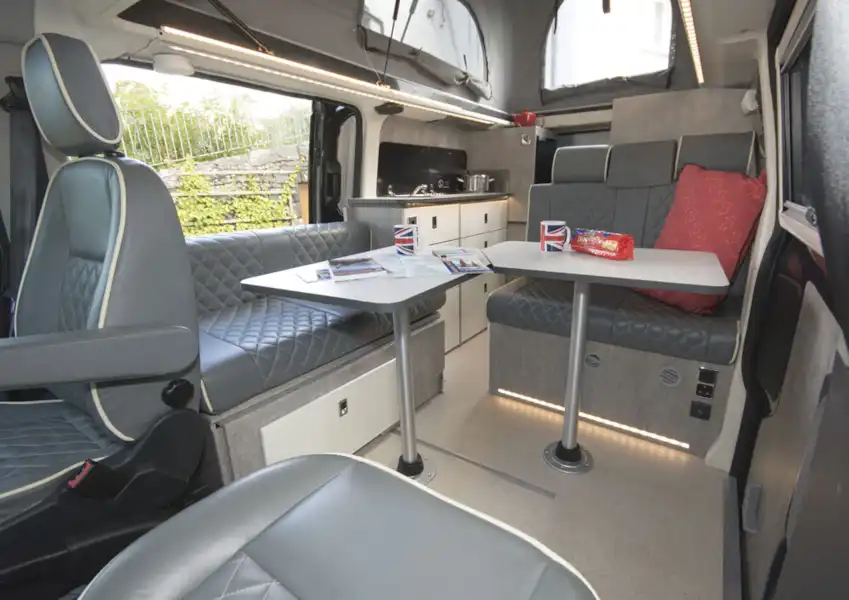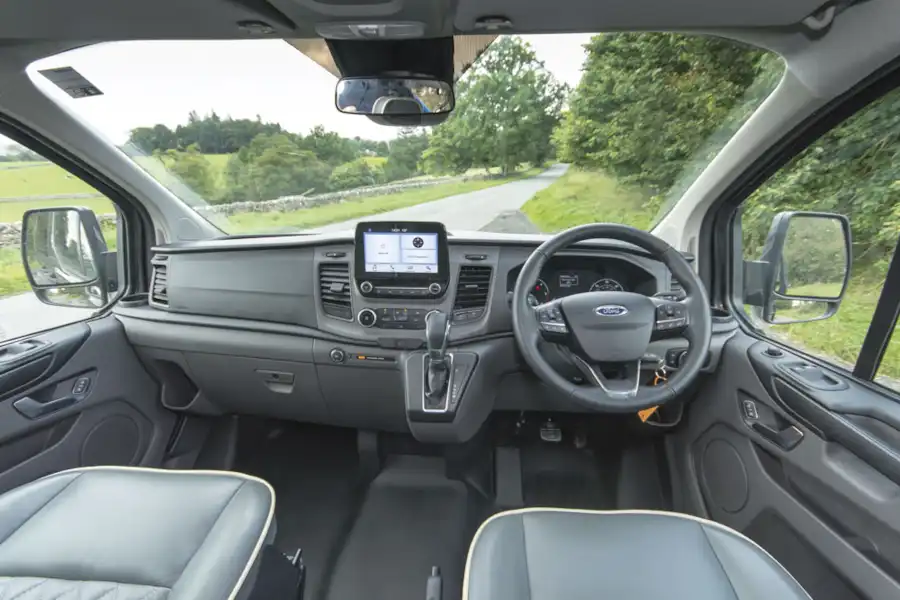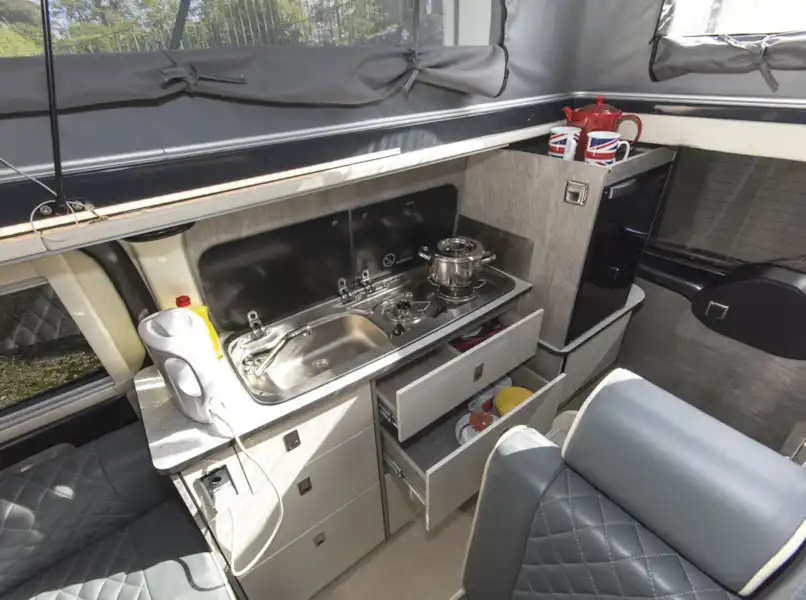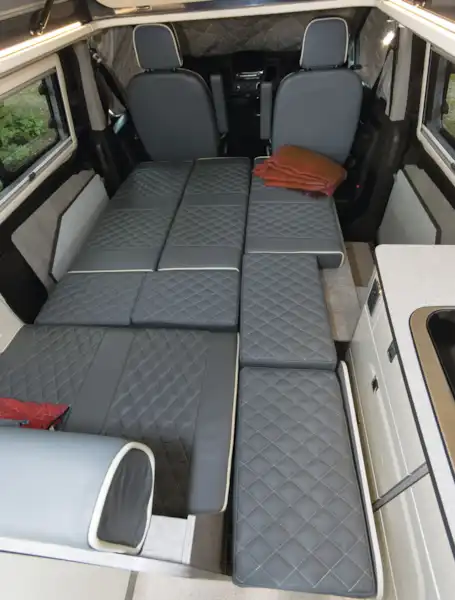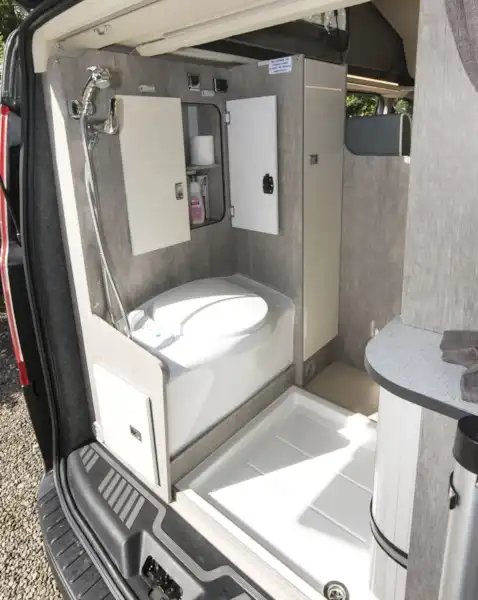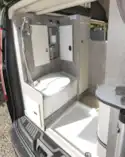Key Features
| Model Year | 2020 |
| Class | Rising Roof |
| Base Vehicle | Ford Transit Custom |
| Price From (£) | 51,995 |
| Length (m) | 5.34 |
| Berths | 4 |
| Belted Seats | 4 |
| Main Layout | End Washroom |
At a glance
Full review
Words & Photos by Andrew & Rona Bromley
When we visited Halifax-based WildAx Motorhomes, the factory and yard were bustling with campervans under construction and awaiting collection. Among the many Citroën Relays and lone Mercedes Sprinter was the campervan we’d come to see – the Triton, based on the latest Ford Transit Custom, with a rising roof and novel interior.
WildAx is now part of the French Rapido empire, so the company has access to new continental ideas and designs, while retaining free rein to design and produce its own campervans. The Triton, a product of this process, gives WildAx an entrée into a different market sector, with the layout (and many of its components) being similar to the Cap Land (a campervan produced by another Rapido company, Dreamer), but tweaked by WildAx to cater better for the British market.
The Transit Custom is a formidable competitor to the long-established market leader, VW’s T6 Transporter. In many ways, the Custom is superior, not least in terms of value for money. The Triton, based on a Trend-spec Transit Custom long-wheelbase, has cab air-conditioning, cruise control, front foglights, a leather steering wheel with audio controls, a reversing camera, automatic lights and wipers and a heated windscreen. Costing from £50,865 – with the six-speed torque converter automatic gearbox priced at a reasonable £1,750 extra – you’d search hard to find a new, similarly specified LWB VW Transporter campervan at anywhere near this price.
The cab in the WildAx Triton campervan
The Custom cab is modern and ergonomic, with a clear touchscreen display for the DAB radio, as well as a fully adjustable steering wheel and comfortable seats, both with armrests. The dash-mounted gearlever for the automatic gearbox has the usual format, but it’s rather too easy to slip past ‘D’ (drive) to ‘M’ (manual) and then wonder why the engine is still revving hard in first. But, if you like automatics, you’ll enjoy this.
The Custom has stop/start, though this can be switched off, if preferred. The twin lens door mirrors give better visibility than the VW’s and the reversing camera is
clearer and more sophisticated than the Transporter’s, having guidelines which adjust with the steering.
The Triton’s 2-litre, 130bhp engine is lively, responsive and feels surprisingly powerful. Despite having (optional) eye-catching 18in alloys with 50 profile tyres (usually a recipe for a rock-hard ride), its suspension is supple enough to manage a heavily potholed track with aplomb, and it handled extremely well at speed on bendy roads. Meanwhile, the trip computer indicated fuel consumption in the mid-thirties.
At 5.34m, the Triton is slightly longer than the equivalent T6 LWB, and wider, too. The colour-coordinated elevating roof is set low and is hardly noticeable; although, at 2.01m high, limbo-dancing under height barriers isn’t worth risking!
You might think a retractable step on a campervan unnecessary but, as the door is low, and you stoop to enter, the step really assists. There’s also an offside sliding door, but entry is blocked by a (removable) settee.
Raising the roof in the WildAx Triton campervan
The front-hinged roof, made by Rapido, rises easily. Enter via the tailgate, release and unclip two straps just above your head, reach into the gap between the roof frame and the bed, give it a shove, and up it goes, helped by gas struts. Another quick push and the roof bed follows, leaving masses of headroom – at least towards the rear of the campervan (headroom reduces considerably towards the cab). There’s the usual arrangement of half-moon, zipped mesh panels to each side and a clear plastic window to the rear. The roof is also very easy to lower.
The brief behind the Triton’s design was to include all the facilities sought in a four-seater/four-berth motorhome, but in a much smaller package. Requiring considerable ingenuity, plus some compromise, the question is how does this work in practice for four holidaymakers and their clobber?
The Triton, on a 3,200kg chassis, has an excellent 450kg payload, and there’s travel seating for four, with the two cab seats and a transverse rear bench with two three-point belts and headrests. The bench is of modest proportions and, for adults, the seat adjacent to the outside wall lacks headroom below the edge of the roof (just 76cm between seat cushion and ceiling). In fact, with the roof lowered, headroom throughout is skimpy. However, there’s a sliding window for passenger ventilation and plenty of legroom.
On site, with roof raised, the cab passenger seat swivels, but, due to the height of the handbrake, the driver’s seat doesn’t. Instead, there’s an inward-facing settee behind it, against the offside sliding door and the same observation about limited headroom applies here.
Two pole-mounted tables fit together in an L-shape, serving both settees and the passenger cab seat (at a stretch). Furniture, in a grey, wood-effect, with glossy off-white cupboard fronts and silver tambour doors to the overhead lockers and under-fridge storage, is very smart, and constructed to WildAx’s usual high standards. Upholstery, including the cab seats, was optional quilted grey leather. At a very reasonable £995 this will doubtless be popular.
The tough flooring has removable carpet sections, including one for the shower tray but, as any mat here can easily slide underfoot, we’d prefer a simple, secure, board insert/cover. Windows have cassette concertina blinds in the lounge, insulated interior screens for the cab and a curtain for the tailgate. The all-LED lighting is good, with adjustable reading lights by the cab seats and powerful high-level LED strips along each side.
In the lounge there’s a mains socket and two USB ports in the travel seat base, plus two more in the handbrake housing.
The offside settee can be unfastened, moving through 90 degrees to face the rear seat, forming a dinette or could be removed altogether, providing a lot more space. Two could then sleep upstairs, relying on the travel bench and the passenger cab seat (the best chair in the house) for seating.
The kitchen in the WildAx Triton campervan
The kitchen work surface contains an integral two-burner hob and sink with inset hot/cold tap. There’s a small prep area at the forward end with mains and 12V sockets underneath. Though convenient for making tea, it’s close to the settee, and there’s no upstand to protect the upholstery from washing-up splashes.
With no oven, there’s plenty of storage in five generous drawers and a floor-level cupboard (which, having holes for five magnum wine bottles, clearly demonstrates the French influence). Rearwards of the kitchen, the 50-litre Vitrifrigo compressor fridge has a raised-edged surface above, which makes a handy shelf, as does the top of the wardrobe opposite.
The WildAx Triton washroom
However, the Triton’s USP is undoubtedly its washroom, located at the back of the campervan. Firstly, there’s a nearside, inward-facing Thetford bench toilet behind the wardrobe and opposite the fridge. Its cassette is easily accessible for servicing via the tailgate but there’s no privacy screen or washbasin.
What’s really unusual is the provision of a shower, the tray occupying most of the rear floor space. This is a seated shower (you perch on the toilet), where you’re shrouded by a mid-height curtain attached by poppers to the side of the wardrobe, the fridge housing and the tailgate, and which is persuaded to remain inside the shower tray by a fringe of small lead weights. With a 50-litre fresh water tank, a Truma Ultrastore boiler to heat the water and a trigger-operated showerhead, a cursory shower is possible.
The shower tray is shallow, though, and, because of the location of the spare wheel, the single drain hole has to be at the rear, so be careful how you park when you do plan on showering! It’s also a bit of a faff dealing with the shower curtain when exiting the washroom and getting dried off, and we questioned whether the provision of hot water on tap is worth forfeiting all the storage space below the travel seat for the Truma boiler. But, if you like off-grid camping, or having your own facilities, it’s a handy facility to have on board.
For sleeping, there are two alternatives. The roof bed is impressive, measuring 1.90m by 1.20m and capable of carrying a maximum of 150kg. The ladder (clipping to the cupboard behind the toilet and blocking its use) eases access and the thin mattress overlies an excellent Froli sprung base. It’s a good bed and, if just two are travelling, it’s probably all you’d need in milder weather.
The other bed, downstairs, is more complex to create, though WildAx claims that – with practice – the procedure takes 30 seconds and has made a YouTube video to prove it. First, turn the cab seat forwards (the cab plays no part in bed-making). Next, standing outside the nearside open doorway, remove the two linked bed cushions from the locker under the side settee and the two extra cushions which fill the drawer under the travel bench. Pull that drawer out towards the kitchen unit, unbolt the side settee base from the floor, and slide it towards you (there are runners in the floor), then unfold it, and that’s the base completed. Now add the eight cushions to make a bed measuring 1.90m by 1.30m. Because of the number of joins, and the way some cushions aren’t confined, meaning you can slide around under your body weight, a mattress topper would be useful.
Storage-wise, there is a good-sized wardrobe and two big cupboards with WildAx’s trademark tambour doors below the fridge. The kitchen drawers and cupboards carry food, utensils, etc, but that’s about it. The valuable space under the two settees, where you’d normally stow bulkier items, houses those extra bed cushions and the boiler. Don’t forget the internal cab screens and ladder have to be stowed, too. These, along with your bedding, will probably be stored in the washroom when on the move.
Expert motorhome advice to your door!
Why not subscribe to one of our fabulous magazines and get expert advice, travel ideas, technical help and all the latest news for your motorhome and your motorhome adventures!
Want to know more about MMM magazine?
Every month MMM has articles written by motorhomers who have been there and done it, from great UK and European (and further afield) tours, campsite reviews, owners' reports and DIY projects among other things. MMM's tests, reviews and expert buying guides are not to be missed. MMM's technical advice is a must and includes everything from weekend jobs to longer-term DIY projects. And much more!
About MMM magazineWant to know more about What Motorhome magazine?
Every issue of What Motorhome magazine provides essential buying advice for anyone looking to buy a new motorhome or campervan or upgrade their existing model. With a pedigree of over 30 years of offering the best motorhome and campervan buying advice, every issue of What Motorhome includes more new motorhome and campervan reviews than you will find in any other magazine.
About What MotorhomeWant to know more about Campervan magazine?
Campervan is the exciting monthly magazine that will give you all the inspiration you need to explore the world in your campervan. Every issue is packed with real-life campervanning experiences, inspiring travel ideas in the UK and further afield, the best campsites to stay on, campervan road tests and reviews of the latest models, and much more!
About Campervan magazine

